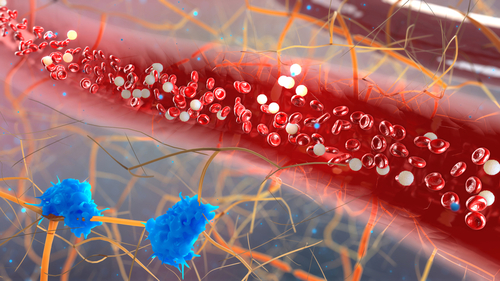Leptin Deficiency Can Lead to Development of AAV, Case Study Suggests

A deficiency in leptin — the hormone that signals the brain when a person has eaten enough — may lead to the development of ANCA-associated vasculitis (AAV), according to a new case study from India.
The report, “ANCA-associated Vasculitis in a Case of Congenital Leptin Deficiency,” was published in the Indian Journal of Dermatology.
Leptin is a hormone released from fat cells in adipose tissue that sends signals to the brain, helping regulate and alter food intake and energy expenditure, with the goal of maintaining an optimal weight.
Leptin has additional roles in regulating the immune system and other physiological responses.
Congenital leptin deficiency is caused by mutations in the LEP gene. Patients with this disease often have severe obesity early in life. Interestingly, this type of leptin deficiency is remarkably rare, with fewer than 30 patients reported in literature.
Leptin deficiency is also thought to play a role in the mechanisms that lead to the development of ANCA-associated vasculitis. In fact, studies have shown that lower leptin levels are associated with higher disease activity. However, cases of congenital leptin deficiency associated with AAV are extremely rare.
In this study, physicians report the case of a 10-year-old girl in India who arrived at the hospital with multiple painful red, raised lesions on the trunk and extremities of her body.
Physical examination revealed purpura (red or purple discolored spots on the skin) and skin lesions of different sizes and shapes over most of her body.
The girl also had moon facies (a rounded facial appearance due to fat deposits), morbid obesity, and a very high body mass index (BMI). Lab tests revealed she was positive for cytoplasmic ANCA, and a skin biopsy suggested a diagnosis of vasculitis.
The patient started to gain weight and eat excessively at 6 months old. Due to early-onset obesity, she was evaluated for leptin deficiency. Her serum leptin levels were significantly low, at 0.8 ng/ml, when the normal range is between 1.7-10.9 ng/ml.
The young girl was diagnosed with leptin deficiency, and her brother was also found to be deficient in leptin. The siblings were likely two cases of congenital leptin deficiency, but a genetic analysis could not be conducted because the service was not available at the center where they were being treated.
The patient was treated with tapering doses of steroids and showed a significant improvement of the skin lesions in the following weeks.
While it was not used as treatment for this patient due to financial issues, leptin replacement therapy has resulted in positive results in cases such as this.
It is still not known why leptin deficiency can lead to AAV, though many researchers have developed theories that could explain this link.
One of the major characteristics of vasculitis is invasion and destruction of the endothelium (the layer of cells that lines blood vessels) by primed neutrophils, a type of immune cell. Interestingly, both endothelial cells and neutrophils express the leptin receptor, suggesting that they are responsive to leptin levels.
Therefore, leptin — when present in normal physiological levels — can bind to those receptors and play a role in stopping neutrophil invasion.
But some studies have even shown that leptin levels are higher during periods of systemic vasculitis. These contrasting results underscore the need to better understand the link between AAV and leptin deficiency.
“Whether leptin has a role in vasculitis or its altered levels in this disorder is a mere coincidental finding needs to be probed. Larger studies are required to consolidate this finding,” investigators wrote.






